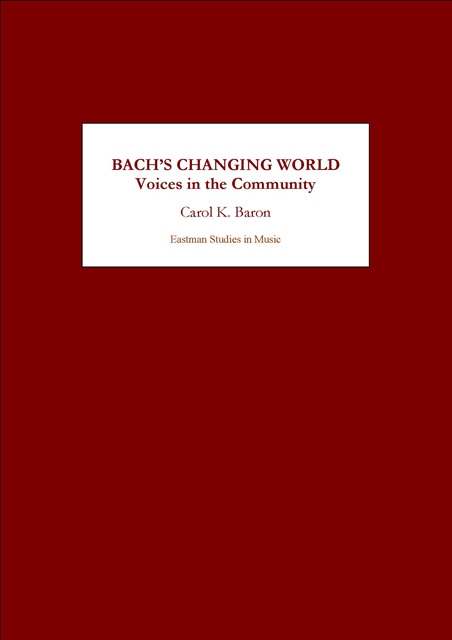Book contents
- Frontmatter
- Dedication
- Map
- Contents
- List of Illustrations
- Editor's Acknowledgments
- 1 Transitions, Transformations, Reversals: Rethinking Bach's World
- 2 Tumultuous Philosophers, Pious Rebels, Revolutionary Teachers, Pedantic Clerics, Vengeful Bureaucrats, Threatened Tyrants, Worldly Mystics: The Religious World Bach Inherited
- 3 Family Values and Dysfunctional Families: Home Life in the Moral Weeklies and Comedies of Bach's Leipzig
- 4 Bach in the Midst of Religious Transition
- 5 Bach's Situation in the Cultural Politics of Contemporary Leipzig
- 6 The Reception of the Cantata during Leipzig Church Services, 1700–1750
- 7 From Salon to Kaffeekranz: Gender Wars and the Coffee Cantata in Bach's Leipzig
- 8 A Treatise on Liturgical Text Settings (1710)
- 9 Random Thoughts About Church Music in Our Day (1721)
- Notes on the Contributors
- Index
- Eastman Studies in Music
6 - The Reception of the Cantata during Leipzig Church Services, 1700–1750
Published online by Cambridge University Press: 17 March 2023
- Frontmatter
- Dedication
- Map
- Contents
- List of Illustrations
- Editor's Acknowledgments
- 1 Transitions, Transformations, Reversals: Rethinking Bach's World
- 2 Tumultuous Philosophers, Pious Rebels, Revolutionary Teachers, Pedantic Clerics, Vengeful Bureaucrats, Threatened Tyrants, Worldly Mystics: The Religious World Bach Inherited
- 3 Family Values and Dysfunctional Families: Home Life in the Moral Weeklies and Comedies of Bach's Leipzig
- 4 Bach in the Midst of Religious Transition
- 5 Bach's Situation in the Cultural Politics of Contemporary Leipzig
- 6 The Reception of the Cantata during Leipzig Church Services, 1700–1750
- 7 From Salon to Kaffeekranz: Gender Wars and the Coffee Cantata in Bach's Leipzig
- 8 A Treatise on Liturgical Text Settings (1710)
- 9 Random Thoughts About Church Music in Our Day (1721)
- Notes on the Contributors
- Index
- Eastman Studies in Music
Summary
Scholars have long engaged in the study of Leipzig musicians and their performance of church music during the Baroque era. One question, though, has largely gone unasked: how did the audiences of J. S. Bach and his contemporaries experience the cantata?
Congregants were a lively presence during the act of worship. They made use of nearly every element of the liturgy, of seating arrangements, and of a range of behaviors to articulate their social status, and to support, protest against, or otherwise comment on the form and content of the service. These included selective forms of listening to and participating in the musical parts of the service. In their turn, clerics and musicians tailored the service in response to the congregation's tastes and habits. There is very little direct evidence on the subject of congregations’ reactions and behavior during this period, so to reconstruct their experience of the service it is necessary to work with a variety of material, most of it not connected with music. In this article I shall first discuss the general context of the service: the make-up of the congregations, church seating and layout, and the course of the liturgy. I shall then look more closely at the cantata itself, examining its place in the service, as well as clues provided by texts and music.
I shall examine most closely worship on Sunday mornings in Leipzig's two main churches, St. Thomas and St. Nicholas, where the principal services were held. Contemporaries considered them the most important regular public meetings in the town, and the core of an individual's religious life. On these occasions senior ministers preached and instrumental music was regularly performed. St. Thomas cantors, who included J. S. Bach from 1723 to 1750 and Johann Kuhnau from 1701 to 1722, performed on alternating Sundays in St. Thomas and St. Nicholas. I shall also investigate the morning services in the “New Church” and the University Church.
The Congregations
The service, which started at 7:00 a.m., was preceded by the ringing of bells, which both symbolized the public status of the service and served as a reminder to the population to congregate. As was usual elsewhere in Europe, the wealthy arrived and departed in carriages.
- Type
- Chapter
- Information
- Bach's Changing WorldVoices in the Community, pp. 174 - 189Publisher: Boydell & BrewerPrint publication year: 2006



